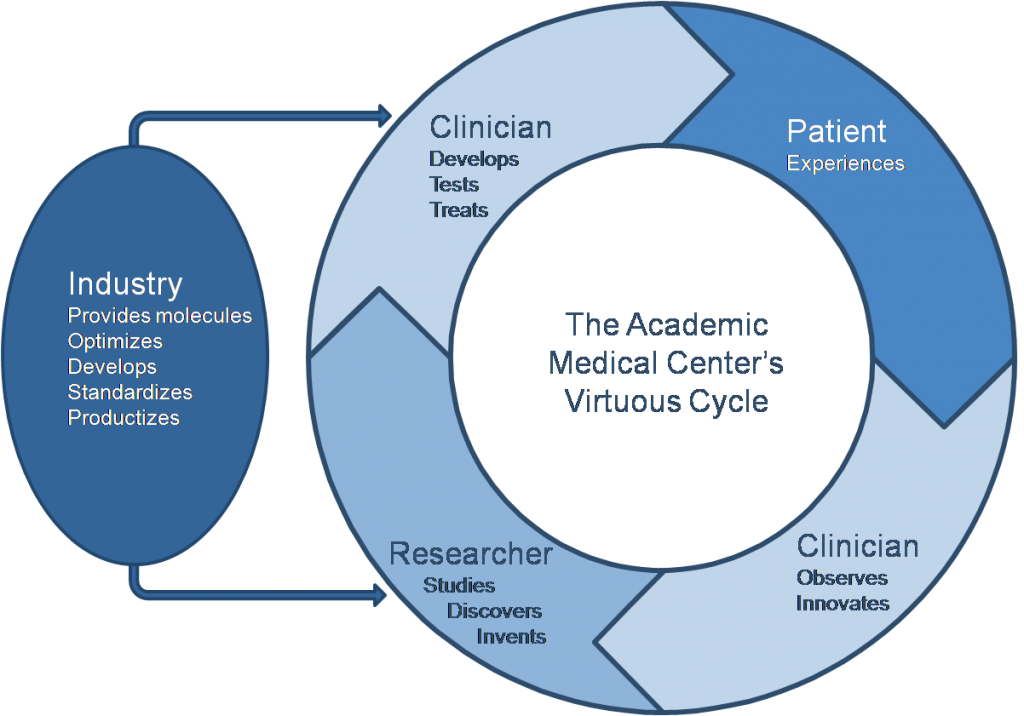
The virtuous cycle of treatment development, and how it can be enhanced by partnership with industry.
When the clinical and research enterprises at an academic medical center are strategically and tactically aligned, they enter a “virtuous cycle,” described by Stephen Wartman, president of the Association of Academic Health Centers. Clinician-researchers embody it: They know their patients’ needs, what treatments are available and the frustration when those options are insufficient. They take clinical problems back to the lab to figure out solutions, and are highly motivated to develop products because their goal begins and ends with helping the patient.
The academic medical center is the epicenter of therapeutic development. It’s where potential drug targets are identified and mapped from animal models to human tissues, and where clinical trials will ultimately take place. Yet, in the past, pharmaceutical and biotech companies have driven drug development, while academia has been a piecemeal contributor through small industry-sponsored research projects or as a clinical trial site.
Now, with changing dynamics within the pharmaceutical industry - mergers, changing priorities, downsizing of internal research — large companies may no longer have the wherewithal to develop therapeutics from beginning to end.
This long-term commitment is exactly what the academic community has. Investigators work in specific areas for decades, knowing specific disease processes and often being able to make well-educated guesses about which new treatments are likely to work and which are apt to fail.
And while industry has become averse to risky early-stage (pre-phase II) projects, academic institutions have an expanding box of tools to support early therapeutic development. The National Institutes of Health, recognizing that independent private-sector drug development is waning, will launch the National Center for Translational Sciences (NCATS) this fall. In Science Translational Medicine, NIH Director Francis Collins argues that while scientific knowledge has expanded dramatically over the past several decades, the methods being applied to preclinical and clinical development have remained the same.
Opinion survey of academic drug development centers. Article (Nature Reviews Drug Discovery): www.nature.com/nrd/journal/v10/n6/full/ nrd3462.html
Collins outlined a few areas —frustratingly familiar to centers like ours— where some targeted innovation could have a big impact. They include therapeutic target validation, chemistry, virtual drug design, preclinical toxicology, biomarkers, efficacy testing (particularly improving on animal models), “phase zero” clinical trials, repurposing of existing drugs, clinical trial design and post-marketing research.
Even with new NIH resources, effective industry partnerships will be essential for success. At Children’s, we have about 100 physician-sponsored INDs, many of which began as laboratory discoveries and observations. Most, if not all, are seeking new uses of available, FDA-approved drugs or devices to benefit new groups of patients. This often requires us to partner with the originator of the drug or device.
Some companies obstruct our efforts, viewing any work with their proprietary material as a potential liability. But most welcome the collaboration, seeing it as a way to enhance their product line and build a relationship with key thought leaders. Even when their support is not financial, these projects are more likely to produce successful long-term relationships and new products.
With an industry partner, a center’s work can have global reach; without it, solutions may be effective on a small scale, but never realize their full impact. Together, we have the way to complete the lab-to-clinic “virtuous cycle”: Industry has the molecules, chemistry optimization, expertise on druggability, clinical development and regulatory programs, while academic medicine has target discovery, early animal testing, clinical trials and ultimately, the patients who can be treated and tracked.
Academic medical centers are in an increasingly good position to lead “fully integrated early therapeutic development networks” (akin to pharma’s “FIPNets”), marshaling resources from the NIH, industry and other innovation catalysts such as foundations and patient advocacy groups. Each center will have to decide for itself which opportunities to pursue, how far to take them and how to best use partnerships to achieve its core mission. Partnership structures that carefully and painstakingly align incentives (see company examples in yesterday’s post) will complete the virtuous cycle and benefit all involved — most importantly, patients.
Nurjana Bachman, PhD, is Business Development Manager in theTechnology & Innovation Development Office (TIDO) at Children’s Hospital Boston.






